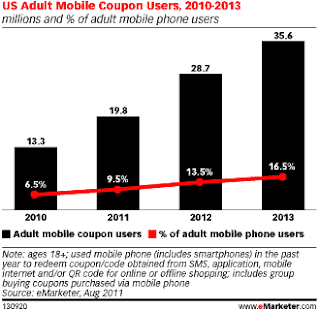Unlike traditional rewards programs used by financial institutions that are points based and driven by the volume of transactions processed, the Cardlytics platform provides the ability to present highly targeted retailer offers to customers through a bank's online statement, mobile device or email based on the customer's recent transaction activity. Since the Cardlytics decisioning tool resides within the bank's firewalls, customer insight never leaves the bank and retailers never have access to proprietary customer information. In addition, as opposed to the points reward program being a cost to the bank, the Cardlytics pay-for-performance model not only eliminates risk for the merchant, but also can provide much needed revenues for the partner bank.
The Cardlytics solution has been so well received, that as many as 70% of U.S. households could have such a program tied to their bank's debit and/or credit card relationship by Q1 of 2012, according to Scott Grimes, Cardlytics' CEO. This amazing growth and acceptance begs the question . . . if all the banks have the same program, how can differentiation be achieved and maintained?
In an interview with Lynne Laube, President and COO of Cardlytics earlier this year, I asked her how banks can leverage the Cardlytics platform and retail partnerships beyond simply offering the same offers as the bank down the street. She explained that while most bank clients will have many of the same nationwide retail partners, there will the capability to offer significant regional or even local offers. While some of these merchant partnerships might be initiated by Cardlytics, individual financial institutions can also link retailers to the platform.
For industrious financial organizations, the ability to offer current or prospective corporate, commercial or small business clients with highly targeted audiences who are prone to buy their products could be a strong business development and retention strategy for calling officers. It also would differentiate the bank's reward program from others across the country. By expanding the program's merchant partnerships, the retail and small business customers will also receive more targeted offers, making the program more valuable to the customer.
Another way a bank can differentiate a merchant-based rewards program will be to expand the channel integration of the merchant offers. Beyond simply providing the targeted offer as part of online statementing, the individual bank's ability to seamlessly integrate the offers into email, SMS alerts and even mobile channels will increase customer engagement and loyalty. Leveraging GPS capabilities could enable customers to receive onsite rewards at merchants they frequent or merchants within a defined radius.
According to an eMarketer study released today, while mobile coupons still represent a small portion of digital promotions, popularity and usage is growing at a rapid pace. It is believed that mobile couponing may grow by as much as 80% over the next two years fueled by the growth of smartphone users. Banks' ability to take advantage of this mobile trend will be the foundation for future rewards program growth.
Potentially most powerful from a differentiation perspective, Laube mentioned that insights from ongoing transaction monitoring can provide valuable behavioral insights that can assist in customer and household segmentation and even financial product cross-selling. Banks could leverage merchant rewards as a 'virtual currency' for different segments of customers or could provide merchant offers as an incentive for consolidation of relationships. As banks begin to introduce more advanced PFM and other money management tools, this type of rewards platform can also be integrated into the customer dashboard.
In a world filled with offers from Groupon, Living Social and more than 600 other competitors, the marketplace for untargeted offers may be reaching a saturation point. According to research firm, Lab42, while 44 % of households use deal websites, 55% feel overwhelmed by the number of offers filling up their email box. Given this mixed landscape, the ability to provide highly targeted, timely and valuable offers will be the key to effective differentiation.
What do you think?: How else do you think banks could differentiate themselves using merchant-funded rewards?






No comments:
Post a Comment